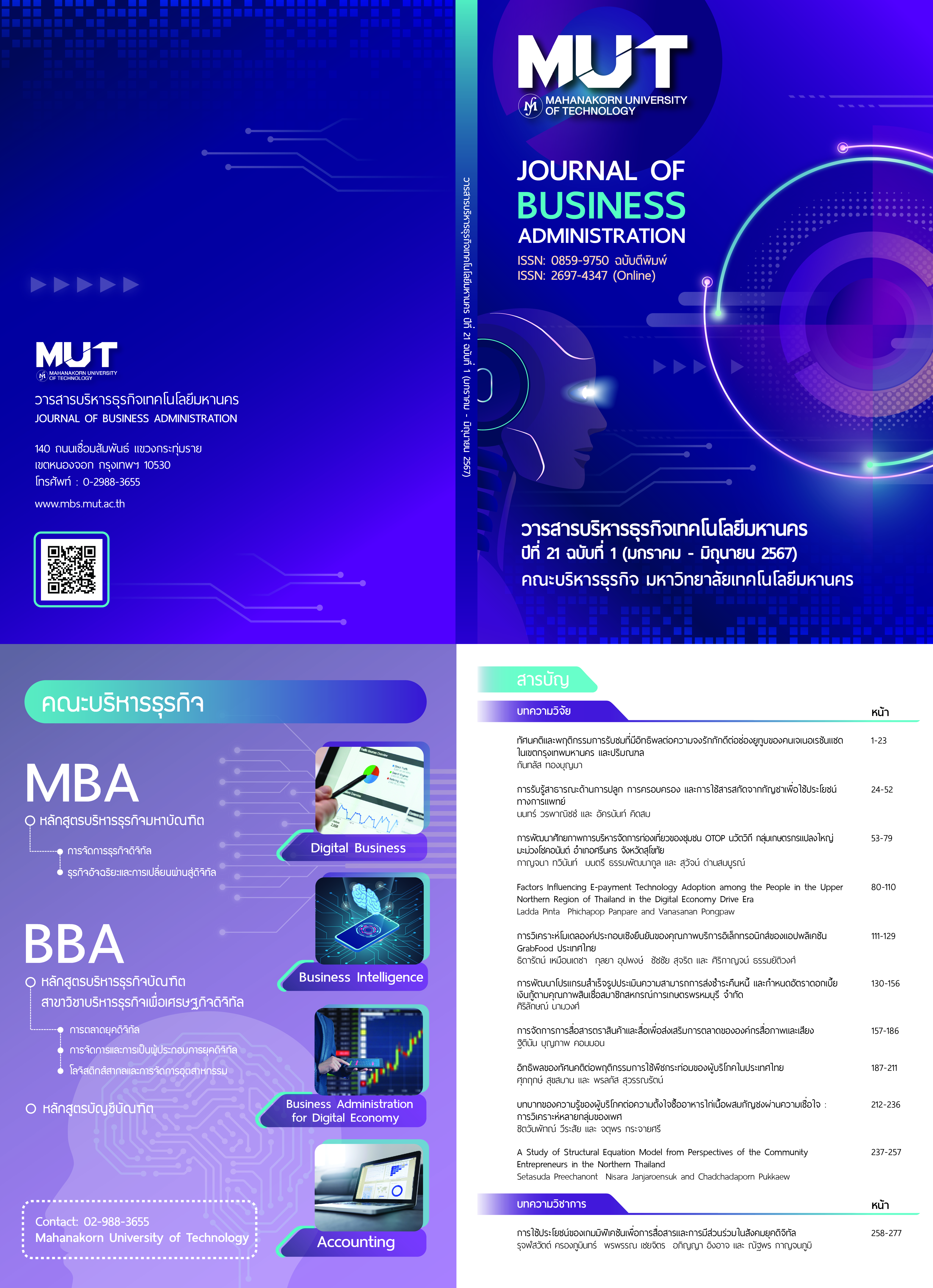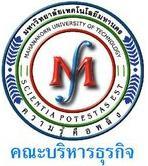Attitudes and Viewing Behavior Influencing YouTube Channel Loyalty among Generation Z in Bangkok and its Vicinity
Keywords:
attitude, behavior, loyalty, YouTube channel, Generation ZAbstract
The objectives of this study were to study 1) the relationships between attitude towards YouTuber’s characteristics, attitude towards program content, viewing behavior and YouTube channel loyalty among Generation Z in Bangkok and its vicinity; and 2) the effects of attitude towards YouTuber’s characteristics, attitude towards program content and viewing behavior on YouTube channel loyalty among Generation Z in Bangkok and its vicinity.
The samples in this study were Generation Z (born between 1997 and 2007) living in Bangkok and its vicinity. In this study, a total of 400 copies of questionnaire were used as the research instrument in the data collection and the data analysis was performed using inference statistics. The hypothesis testing was performed using Pearson’s product moment correlation coefficient and multiple regression analysis. The results showed that the attitude towards YouTuber’s characteristics, attitude towards program content and viewing behavior were positively correlated with YouTube channel loyalty among Generation Z in Bangkok and its vicinity. The correlation coefficients of these relationships in descending order were as follows: attitude towards program content (r=0.684), attitude towards YouTuber’s characteristics (r=0.632), and viewing behavior (r=0.426). The multiple regression analysis revealed that the attitude towards YouTuber’s characteristics, attitude towards program content and viewing behavior influenced YouTube channel loyalty among Generation Z. The effect sizes (β) in descending order were as follows: attitude towards YouTuber’s characteristics (β=0.429), attitude towards program content (β=0.269), and program viewing behavior (β=0.148).
References
Adecco Group Thailand. 2020. Children's Dream Career Survey 2020. Retrieved January 7, 2021 from https://adecco.co.th/en/knowledge-center/detail/research-whitepaper/ children-dream-career-survey-2020
Anekthammakul, P. 2010. Effects of using multiple product (celebrity) in advertising.
A Thesis the Master of Science degree (Marketing Management). Thammasat University.
Anuntasan, K. n.d. Decision in choosing online videos on YouTube. Retrieved June 26, 2021 from https://mmm.ru.ac.th/MMM/IS/vlt15-1/6114993618.pdf
Channarong, S. 2015. Get rich with YouTube 2015. Bangkok: S. Asia press.
Crowdleaks. 2019. Let's get to know YouTubers "New career, increasing income”. Retrieved December 10, 2021 from https://crowdleaks.org/มาทำความรู้จักกับยูทูบ
De Bérail, P., Guillon, M. and Bungener, C. 2019. The relations between YouTube addiction, social anxiety and parasocial relationships with YouTubers: A moderated-mediation model based on a cognitive-behavioral framework. Computers in Human Behavior. 99. 190 - 204.
Department of Provincial Administration. 2022. Population Statistics. Retrieved January 30, 2023 from https://stat.bora.dopa.go.th/new_stat/webPage/statByYear.php
Earthz, A. 2017. Insights into the career of "YouTuber", a new career for people with energy and ideas without limits. Retrieved December 15, 2021 from http:/www.juzzmag.com/job-YouTuber/
Electronic Transactions Development Agency. 2020. Thailand Internet User Behavior 2019. Bangkok: Electronic Transactions Development Agency.
Hayeemad, M. and Polyorat, K. 2013. Brand Loyalty: The Attitudinal and Behavioral Dimensions.
Journal of Business, Economics and Communications. Vol. 8 No. 1. 67 - 73.
Hayes, E. B. 2014. Customer Loyalty is Alive and Well. Retrieved December 20, 2020 from http://businessoverbroadway.com/customer-loyalty-is-alive-and-well
Hemvech, P. 2018. The Influences of Content Presentation Format, Electronic Word-of-Mouth Communication and Trust on YouTube Social Media Users’ Intentions in the Private YouTuber Channel. Master of Business Administration Independent study (Business Administration). Bangkok University.
Holland, M. 2016. How YouTube Developed into a Successful Platform for User-Generated Content. Elon Journal of Undergraduate Research in Communications. Vol. 7 No. 1. 52 - 59.
Iam Inthra, K. 2020. Youtuber & Vlogger, the career of the young generation. Retrieved August 27, 2020 from https://www.bangkokbiznews.com/news/detail/863608
Intasara, W. 2010. 9 Brand Communication: Brand Loyalty. Retrieved January 26, 2022 from http://drwarat.blogspot.com/2010/11/10.html
Jamjuree, D. 2020. Designing of learning for generation z learners. Bangkok: Graduate School of Srinakharinwirot University.
Katzman, J. 2022. The next chapter for Learning on YouTube. Retrieved December 1, 2022 from https://blog.YouTube/news-and-events/the-next-chapter-for-learning-on-YouTube/
Kitchareon, I. 2016. Communication Strategy of Gutumdai Channel for Profit making Through Youtube in TV Program Format. Journal of Communication and Management NIDA.
Vol. 2 No. 2. 56 - 77.
Kuawiriyapan, S. and Suwannamek, O. 2020. Lifestyle of consumers in generation z. Srinakharinwirot business journal. Vol. 8. No. 1. 23 - 43.
LadyBee. 2020. 10 YouTube Statistics Marketers Should Know in 2020. Retrieved December 15, 2020 from https://www.thumbsup.in.th/10-stat-YouTube-for-marketer
Master AD. 2017. Social media measurement for marketing campaign success. Retrieved January 8, 2021 from https://www.masterad.com/news/mediatrend/241MMM/IS/vlt15-1 /6114993618.pdf
McCroskey, J., Hamilton, P. and Weiner, A. 1974. The effect of interaction behavior on source credibility, homophily and interpersonal attraction. Human Communication Research. Vol. 1 No. 1. 42 - 52.
McGuire, W. 1973. The yin and yang of progress in social psychology: Seven koan. Journal of Personality and Social Psychology. Vol. 26 No. 3. 446 – 456.
Mediakix. 2016. The Most Popular types of YouTube Videos. Retrieved November 30, 2020 from http://mediakix.com/2016/02/most-popular-YouTube-videos/#gs.6ug9MX8.
Miller, M. 2011. YouTube for business online video marketing for any business. 2nd Ed. USA: QUE.
Mongkolsiri, S. 2004. Brand management. Bangkok: Love and Lip.
Ohanian, R. 1990. Construction and validation of a scale to measure celebrity endorser's perceived expertise, trustworthiness, and attractiveness. Journal of Advertising.
Vol. 19 No. 3. 39 - 52.
Rattanamungmeka, A. 2015. Attitude exposure and the satisfaction of the audience of GMM 25's Soap Opera Via YouTube. Master of Arts Thesis (Communication Arts and Innovation). National Institute of Development Administration.
Ruamsupthawee, N. 2014. Factors that Influence Customers’ Loyalty to Nation’s Medias. Master of Business Administration Thesis (Business Administration). Nation University.
Siritho, S. and Chanpanya, P. 2012. The measurement and prediction of brand loyalty on mobile phone service providers: The comparison case of AIS, DTAC and TRUEMOVE. MUT Journal of Business Administration. Vol. 9. No. 2. 1 - 19.
Sriprom, C., Rungswang, A., Sukwitthayakul, C. and Chansri, N. 2019. Personality Traits of Thai Gen Z Undergraduates: Challenges in the EFL Classroom. PASAA. Vol. 57.
- 190.
Thangprasitsil, A. 2019. The Reliability of Information Sources on Facebook that affect Behavior of Information Transmission. Master of Communication Arts Thesis (Strategic Communication). Bangkok University.
Thinkwithgoogle. 2019. Survey: How do Thai people use YouTube? Retrieved January 8, 2021 from https://www.thinkwithgoogle.com/intl/th-th/consumer-insights/consumer-trends/rediscover-thai-youtube-behavior-2019/
Umeogu, B. 2012. Source credibility: a philosophical analysis. Open journal of philosophy. Vol. 2. No. 2. 112 - 115.
United Nations Thailand. 2021. Online employability resources for youth 2021. Retrieved December 10, 2022 from https://thailand.un.org/en/167493-online-employability-resources-youth-2021
Vongfant, C. 2017. Personal branding, followers building and maintaining of professional YouTubers and the opinion of followers. Master of Science Independent study (Marketing management). Thammasat University.
Wongmontha, S. 1999. Analyzing consumer behavior. Bangkok: Theera film and Scitex.
Additional Files
Published
Issue
Section
License

This work is licensed under a Creative Commons Attribution-NonCommercial-NoDerivatives 4.0 International License.
ข้อความ ข้อคิดเห็น ข้อมูล เนื้อหา รูปภาพ แผนภูมิ แผนผัง เป็นต้น ที่ปรากฏและแสดงในบทความต่างๆ ในวารสารบริหารธุรกิจเทคโนโลยีมหานคร ถือเป็นความรับผิดชอบโดยตรงของผู้เขียนบทความนั้นๆ มิใช่เป็นความรับผิดชอบใดๆ ของวารสารบริหารธุรกิจเทคโนโลยีมหานคร และมหาวิทยาลัยเทคโนโลยีมหานคร
บทความที่ตีพิมพ์ในวารสารบริหารธุรกิจเทคโนโลยีมหานคร ถือเป็นลิขสิทธิ์เฉพาะของคณะบริหารธุรกิจ มหาวิทยาลัยเทคโนโลยีมหานคร หากบุคคลหรือหน่วยงานใดต้องการนำทั้งหมดหรือส่วนใดส่วนหนึ่งไปเผยแพร่ต่อหรือเพื่อกระทำการใดๆ จะต้องได้รับการอนุญาตเป็นลายลักษณ์อักษรจากคณะบริหารธุรกิจ มหาวิทยาลัยเทคโนโลยีมหานครก่อนเท่านั้น


